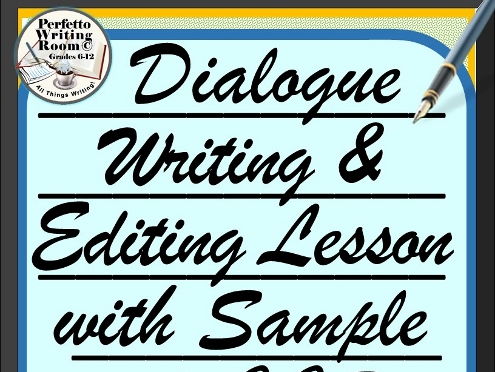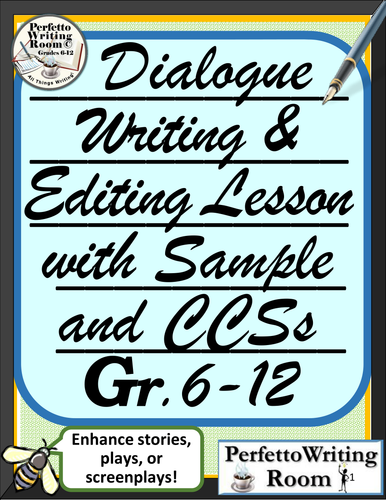

“Dialogue Writing & Editing Lesson with Sample and CCSs Gr. 6-12” is the second resource in our line of dialogue writing resources. Part one of our dialogue writing series focused on learning the definition and rules of writing and formatting dialogue.
THIS second resource is the next step, a logical 9-day lesson with a step-by-step approach that scaffolds students from “information getting” to writing and editing on their own. This more challenging resource focuses on writing purposeful, authentic-sounding dialogue, cutting lines that don’t work, and rewriting as needed.
Self-assessments, task- and skill-based handouts, and discussions in which students are asked to explain why they made certain choices all assure an increased ability on the part of the student to perform the required tasks, but also ensure that the instructor knows where the students are regarding their skill and comfort level.
The goals of this resource are:
• To make student writers actively aware of the many roles and purposes dialogue can serve in fiction, plays or screenplays so that the fiction writing as a whole will improve.
• To have students recognize, discuss, and apply natural-sounding dialogue in their own work, thereby improving overall writing quality and character “believability.”
• To actively pursue an annotation process in which they will label a useful purpose to each line in a sample dialogue or cut it, as a practice for their own editing process.
• To write their own dialogue scene with a natural voice and with purposes that serve the plot or the characters, and to go through a rigorous editing process as performed previously in the annotation practice.
• To rewrite their final dialogue scene for a grade.
Students will:
o Refresh, reintroduce key concepts. Worksheets are provided
o Recognize and report on natural patterns of authentic dialogue in “Real-Life Dialogue Activity” discussing ways they will apply it to their own written dialogues.
o Immediately apply what they’ve learned about authentic dialogue in an introductory dialogue writing exercise, “An Unlikely Pair!”
o Learn about “purposes” in dialogue. Just a few of these are:
background information,” “forwarding the plot” or “character development.” In an annotation activity, students label a strong sample dialogue sample, “One Minute to Armageddon!” with the purpose each line serves, but cut the lines that are useless or extraneous.
o The final activity – “Kill Your Darlings, Darling!” Complete an entire dialogue scene from beginning to end. They
THIS second resource is the next step, a logical 9-day lesson with a step-by-step approach that scaffolds students from “information getting” to writing and editing on their own. This more challenging resource focuses on writing purposeful, authentic-sounding dialogue, cutting lines that don’t work, and rewriting as needed.
Self-assessments, task- and skill-based handouts, and discussions in which students are asked to explain why they made certain choices all assure an increased ability on the part of the student to perform the required tasks, but also ensure that the instructor knows where the students are regarding their skill and comfort level.
The goals of this resource are:
• To make student writers actively aware of the many roles and purposes dialogue can serve in fiction, plays or screenplays so that the fiction writing as a whole will improve.
• To have students recognize, discuss, and apply natural-sounding dialogue in their own work, thereby improving overall writing quality and character “believability.”
• To actively pursue an annotation process in which they will label a useful purpose to each line in a sample dialogue or cut it, as a practice for their own editing process.
• To write their own dialogue scene with a natural voice and with purposes that serve the plot or the characters, and to go through a rigorous editing process as performed previously in the annotation practice.
• To rewrite their final dialogue scene for a grade.
Students will:
o Refresh, reintroduce key concepts. Worksheets are provided
o Recognize and report on natural patterns of authentic dialogue in “Real-Life Dialogue Activity” discussing ways they will apply it to their own written dialogues.
o Immediately apply what they’ve learned about authentic dialogue in an introductory dialogue writing exercise, “An Unlikely Pair!”
o Learn about “purposes” in dialogue. Just a few of these are:
background information,” “forwarding the plot” or “character development.” In an annotation activity, students label a strong sample dialogue sample, “One Minute to Armageddon!” with the purpose each line serves, but cut the lines that are useless or extraneous.
o The final activity – “Kill Your Darlings, Darling!” Complete an entire dialogue scene from beginning to end. They
Something went wrong, please try again later.
This resource hasn't been reviewed yet
To ensure quality for our reviews, only customers who have purchased this resource can review it
Report this resourceto let us know if it violates our terms and conditions.
Our customer service team will review your report and will be in touch.
$10.00